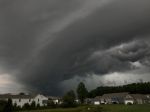Clint O’Connor, The Plain Dealer
Filmmakers are fascinated by Cleveland’s legendary thugs. Especially if their deaths were triggered by exploding automobiles in the 1970s. A new movie and two new documentaries will arrive in 2011, feeding America’s unending appetite for mob stories with a grisly slice of Cleveland’s criminal past. “The Irishman” out next March, spotlights gangster Danny Greene, whose life was famously extinguished by a car bomb in a Lyndhurst parking lot; racketeer Shondor Birns, shredded by a car bomb on Detroit Avenue near West 25th Street; and mafia-connected Teamster official John Nardi, wiped out by a car bomb just off East 22nd Street near Carnegie Avenue.
Birns was killed in March 1975. Nardi in May 1977. Greene in October 1977. Bang. Bam. Boom. If you were a Cleveland mobster in the ’70s, public transportation would have been a smart choice.
Our ever-striving region actually topped the nation in something in 1976, though it was a dubious distinction: No. 1 in bombings. There were 37 in Cuyahoga County, including 21 in Cleveland. Car bombs were relatively cheap to make, easy to plant, could be detonated from afar, and destroyed lots of evidence.
The film stars Irish actor Ray Stevenson as Greene, Vincent D’Onofrio as Nardi, Paul Sorvino as mob boss Anthony “Fat Tony” Salerno, Val Kilmer as a Cleveland detective, and in a stroke of inspired casting, Oscar-winner Christopher Walken playing Birns.
The question isn’t why there’s suddenly a rash of Danny Greene movies. The question is: With such a camera-ready life, why haven’t several been made already?
A fearless hood who grabbed headlines for nearly 15 years, Greene was a colorful character. Literally. He dressed in green, drove green cars, signed his name in green ink. He embraced Irish history and Celtic lore.
Alternately a union troubleshooter, embezzler, and enforcer, Greene dabbled in racketeering, gambling, and loan-sharking.
He excelled at beating the rap, which may have been attributed to his other occupation: FBI informant. Police have long assumed, but never proven, that Greene conspired to take out Birns, a rival in Cleveland’s lucrative numbers racket, and later mafia underboss Leo “Lips” Moceri, whose body was never found.
Greene also possessed an amazing feline facility for dodging death, surviving at least four murder attempts.
“He was larger than life,” said Porrello. “Very charismatic. Very bold. The people hired to kill him didn’t want to get too close. He had this air of invincibility.”
Greene is a Cleveland story, from his early days at the Parmadale orphanage to the streets of Collinwood, to a brief stint in suburban Willoughby. And though his dangerous life was marked by the sensational bursts of violence and mob intrigue that Hollywood loves, a new movie also means opening old wounds for those he left behind: five children and two ex-wives who still live in the area.
Danny Kelly, Greene’s oldest son, was 17 when his dad was killed. Growing up, he helped out with various tasks including crawling under his dad’s car to check for plastic explosives. Kelly, who goes by his mother’s maiden name, is not involved with the film and declined to discuss it. The one question he agreed to answer was: What was your dad like?
“He was Irish, Irish Catholic,” said Kelly. “He believed the man upstairs pulled the strings and that there was someplace to go after this. Where he is today, he wouldn’t trade places with either me or you here. He was truly intrepid. He did everything with humor. If you know somebody that has that charisma, that magnetism of the Irish personality, that was him. He probably could have been governor or senator if he hadn’t gone the other way.”
And one more thing. “He was an orphan. Most of the orphans I know are always scared that eventually they’re going to not have something again. They tend to want to grab everything they can get right now.”
Greene, the ultimate street hustler, first became a public figure when he headed up the Longshoreman’s union on Cleveland’s docks in the early 1960s.
“He reminded me of Marlon Brando in ‘On the Waterfront,’ ” said Ed Kovacic, a former Cleveland Police detective, and later police chief, who spent years tussling with Greene and his cohorts.
“After you broke through that veneer that he put on, you could see he was such a convoluted character. He had so many sides. So many faces. Basically, he was a pretty decent guy who got caught up with living up to reputation, the image of being Danny Greene.”
The image also included generosity. Greene helped out neighbors with money and favors. On Thanksgiving and Christmas, he bought dozens of turkeys and passed them out to needy folks in Collinwood.
OSU student’s fascination with Greene led to movie
“The Irishman” has been in the works since 1997. It began with a Buckeye.
Tommy Reid, a student at Ohio State University in the mid- ’90s, would drive up to Cleveland with friends for various weekend excursions. That’s when he started hearing stories about the area’s explosive criminal past.
“My heritage is Irish and Italian,” said Reid. “I wanted to tell a story that had significance in both nationalities, and me being from New Jersey, which has always been kind of home to the mob, you know, the East Coast, I saw the Danny Greene story as an ideal mission and purpose for my career.”
Reid was so taken with the saga, that he is also the producer and director behind the documentary “Danny Greene: The Rise and Fall of the Irishman.” “””‘”He hooked up with Porrello in 1997 and acquired an option on the book before it was published.
Porrello, who grew up in Cleveland Heights, had his own colorful past. He toured the world as a drummer for Sammy Davis Jr., and later became an author with the book “The Rise and Fall of the Cleveland Mafia,” which featured his own grandfather and great-uncles as players in the bootleg wars of the 1920s and 1930s.
Story Compliments Of The Plain Dealer
















